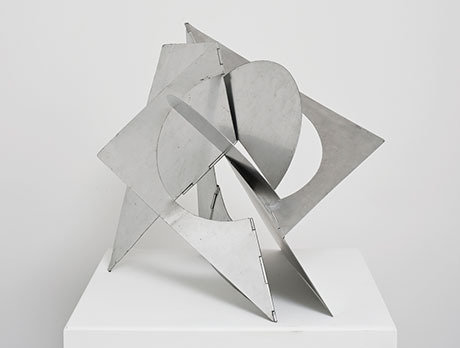Lygia Clark
dal 23/9/2014 al 3/1/2015
Segnalato da
23/9/2014
Lygia Clark
Henry Moore Institute, Leeds
Organic Planes. The exhibition gives a snapshot of the moment when her practice moved from the wall to the hand. The focus is a sculpture from 1960, 'Bicho, Creature in Space', contextualised by a series of collages made in 1957.

Brazilian artist Lygia Clark (1920-88) radically innovated the relationship between the art object and the audience. The focus of this exhibition is a sculpture from 1960, 'Bicho Pássaro do Espaço' ('Bicho, Creature in Space'), contextualised by a series of collages made in 1957. Concurrently, a single architectural scale sculpture by Clark, 'Fantastic Architecture I', is on display until the end of October at Henry Moore's former home and studio in rural Hertfordshire.
Clark's ground-breaking work has become a reference point for artists pushing the limits of sculpture today. Her approach was built on a singular experience that delivered authorship to the spectator and sought to break the space between the artwork and perception. This focused exhibition gives a snapshot of the moment when her practice moved from the wall to the hand.
The three square collages, 'Planos em superfície modulada' ('Plans in modulated surface', 1957) push at the limits of the frame, twisting the plane into three-dimensional space using an active geometry. Clark had a constant practice of writing alongside making work, which included highly productive correspondences with the artist Hélio Oiticica (1937-80). Three years after making these works, in a text titled 'The Death of the Plane', she noted that the plane was an invented concept, driven by a human desire for balance, which she sought to undo through intuitive, 'organic' thinking, announcing that 'demolishing the plane as a support of expression is to gain awareness of unity as a living and organic whole.'
In 1960 Clark's investigation of the plane developed in the series known as 'Bichos', which translates from Portuguese as 'animal' or creature'. Made from hinged metal plates, some circular, others horizontal, these objects were explicitly intended to be handled by the viewer. Clark describes in 1960 that: 'I gave the name "Bichos" to my works of this period because their characteristics are fundamentally organic. Furthermore, the hinge between the planes reminds me of a backbone. The arrangement of metal plates determines the positions of the "Bicho", which at first glance seem unlimited. When asked how many moves a "Bicho" can make, I reply, "I don't know, but it knows."' Folded flat, a 'Bicho' is a plane, manipulated it becomes a creature with a mind of its own. Seen beside the modulated planes, shallow reliefs that slip off the wall and drawing in all that surround them, Lygia Clark: Organic Planes presents the artist's innovative call for intuitive interactions with artwork. Over fifty years on, the discourse around the relationship between viewer and object continues. Whilst the viewer is no longer invited to touch these sculptures, they will be repositioned a number of times during the exhibition to acknowledge the spirit of their making.
Clark's process of making the 'Bichos' moved from balsa wood study, where coordinates are annotated and planned, to maquette, and then to final work. Generally these were made by instruction using a particular material to a specific size. The three examples on display reveal her research-led process, and all were all made by Clark herself. Around seventy 'Bichos' were made in total, and in 1963 Clark moved from away from object making. In this year she made one titled 'Arquitectura fantástica' ('Fantastic Architecture'), which was intended to be scaled up to the size of a building. Impossible in her own lifetime, this ambition was realised in 2013. Until the end of October this sculpture will be on show at The Henry Moore Foundation's Perry Green site; Moore's former home and studio. In 'Fantastic Architecture' the body literally enters the work, prefiguring Clark's innovative non-object thinking that would follow in the next twenty-five years of her art making, drawing on all of the senses.
Lygia Clark: Organic Planes continues a series of study exhibitions that address key sculptural questions through a single work. It is bracketed by two exhibitions in Galleries 1, 2 & 3. The first part of the exhibition will bring the two most important Latin-American artists together: Gego (Gertrud Goldschmidt, 1912-94) and Lygia Clark. Gego. Line as Object is the first UK solo presentation of the Venezuelan artist, and it traces her study of the line from 1957 to 1991. In the second part, Clark is coupled with the group exhibition The Event Sculpture that invites nine contemporary artists to make new work that directly addresses the temporal nature of sculpture. This is an exhibition that explores sculpture in the present tense: a concept that directly derives from Clark's research.
Image: Lygia Clark, 'Bicho Pássaro do Espaço' (Maquette), 1960. Aluminum © 'The World of Lygia Clark' Cultural Association, Rio de Janeiro. Photo: Michael Brzezinski
Press enquiries
The Henry Moore Foundation
Rebecca Land
Rebecca@henry-moore.org
+44 (0)113 246 7467
Henry Moore Institute
74 The Headrow - Leeds LS1 3AH
Galleries open Tuesday - Sunday: 11am - 5.30pm



